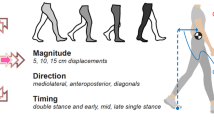Abstract
In recent years, gene regulatory networks (GRNs) have been proposed to work as reliable and robust control mechanisms for robots. Because recurrent neural networks (RNNs) have the unique characteristic of presenting system dynamics over time, we thus adopt such kind of network structure and the principles of gene regulation to develop a biologically and computationally plausible GRN model for robot control. To simulate the regulatory effects and to make our model inferable from time-series data, we also implement an enhanced network-learning algorithm to derive network parameters efficiently. In addition, we present a procedure of programming-by-demonstration to collect behavior sequence data of the robot as expression profiles, and then employ our network-modeling framework to infer controllers. To verify the proposed approach, experiments have been conducted, and the results show that our regulatory model can be inferred for robot control successfully.












Similar content being viewed by others
References
Guo H, Meng Y, Jin Y (2009) A cellular mechanism for multi-robot construction via evolutionary multi-objective optimization of a gene regulatory network. Biosystems 98:193–200
Trefzer MA, Kuyucu T, Miller JF et al (2010) Evolution and analysis of a robot controller based on a gene regulatory network. In: Proceedings of international conference on evolvable systems, LNCS-6274
Davison EH, Rast JP, Oliveri P et al (2002) A genomic regulatory network for development. Science 295:1669–1678
Karlebach G, Shamir R (2008) Modelling and analysis of gene regulatory networks. Nat Rev Mol Cell Biol 9:770–780
Lee W-P, Tzou W-S (2009) Computational methods for discovering gene networks from expression data. Brief Bioinform 10:408–423
van Riel NAW (2006) Dynamic modelling and analysis of biochemical networks: mechanism-based models and model-based experiments. Brief Bioinform 7:364–374
Noman N, Iba H (2007) Inferring gene regulatory networks using differential evolution with local search. IEEE/ACM Trans Comput Biol Bioinform 4:634–647
Xu R, Venayagamoorthy GK, Wunsch D II (2007) Modeling of gene regulatory networks with hybrid differential evolution and particle swarm optimization. Neural Netw 20:917–927
Blasi MF, Casorelli I, Colosimo A et al (2005) A recursive network approach can identify constitutive regulatory circuits in gene expression data. Physica A 348:349–370
Chen CC, Zhong S (2008) Inferring gene regulatory networks by thermodynamic modeling. BMC Genomics 9:S19
Laubenbacher R, Stigler B (2004) A computational algebra approach to the reverse engineering of gene regulatory networks. J Theor Biol 229:523–537
Stewart F, Taylor T, Konidaris G (2005) METAMorph: experimenting with genetic regulatory networks for artificial development. In: Proceedings of the eighth European conference on artificial life, pp 108–117
Bentley PJ (2009) Methods for improving simulations of biological systems: systemic computation and fractal proteins. Interface J R Soc 6:S451–S466
Nakaoka S, Nakazawa A, Kanehiro F et al (2007) Learning from observation paradigm: leg task models for enabling a biped humanoid robot to imitate human dance. Int J Rob Res 26:829–844
Grimes DB, Rao RPN (2008) Learning nonparametric policies by imitation. In: Proceedings of IEEE/RSJ international conference on intelligent robots and systems, pp 2022–2028
An M, Taura T, Shiose T (2007) A study on acquiring underlying behavioral criteria for manipulator motion by focusing on learning efficiency. IEEE Trans Syst Man Cybern A 37:445–455
Muehlig M, Gienger M, Hellbach S et al (2009) Task-level imitation learning using variance-based movement optimization. In: Proceedings of IEEE international conference on robotics and automation, pp 1177–1184
Calinon S, Guenter F, Billard A (2007) On learning, representing, and generalizing a task in a humanoid robot. IEEE Trans on Syst Man Cybern B 37:286–297
Gupta MM, Jin L, Homma N (2003) Static and dynamic neural networks: from fundamentals to advanced theory. Wiley-IEEE Press, NJ
Vohradsky J (2001) Neural network model of gene expression. FASEB J 15:846–854
van Someren EP, Wessels L, Reinders M et al (2002) Regularization and noise injection for improving genetic network models. In: Zhang W, Shmulevich I (eds) Computational and statistical approaches to genomics. Kluwer, Dordrecht, pp 211–226
Bishop CM (1994) Training with noise is equivalent to Tikhonov regularization. Neural Comput 7:108–116
Werbos PJ (1990) Backpropagation through time: what it does and how to do it. Proc IEEE 78:1550–1560
Jacobs RA (1998) Increased rates of convergence through learning rate adaptation. Neural Netw 1:295–307
Zentall TR (2006) Imitation: definitions, evidence, and mechanisms. Anim Cogn 9:335–353
Rizzolatti G, Craighero L (2004) The mirror-neuron system. Annu Rev Neurosci 27:169–192
Japkowicz N, Stephen S (2002) The class imbalance problem: a systematic study. Intell Data Anal 6:429–450
Liu X-Y, Wu J, Zhou Z-H (2009) Exploratory under-sampling for class-imbalance learning. IEEE Trans Syst Man Cybern B 39:539–550
Vu T, Vohradsky J (2002) Genexp: a genetic network simulation environment. Bioinformatics 18:1400–1401
Nolfi S, Floreano D (2000) Evolutionary robotics: the biology, intelligence, and technology of self-organizing machine. MIT Press, MA
Ijspeert AJ (2008) Central pattern generators for locomotion control in animals and robots: a review. Neural Netw 21:642–653
Beer RD, Gallagher JC (1992) Evolving dynamical neural networks for adaptive behavior. Adapt Behav 1:91–122
Diankov R, Kuffner J (2008) Openrave: a planning architecture for autonomous robotics. Technical report CMU-RI-TR-08-34, Robotics Institute, Carnegie Mellon University
Acknowledgments
This work was supported by National Science Council of Taiwan, under contract NSC 96-2221-E-110-081.
Author information
Authors and Affiliations
Corresponding author
Rights and permissions
About this article
Cite this article
Lee, WP., Yang, TH. Combining GRN modeling and demonstration-based programming for robot control. Neural Comput & Applic 20, 909–921 (2011). https://doi.org/10.1007/s00521-010-0496-z
Received:
Accepted:
Published:
Issue Date:
DOI: https://doi.org/10.1007/s00521-010-0496-z




